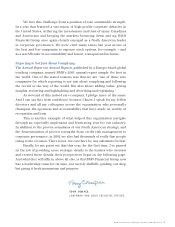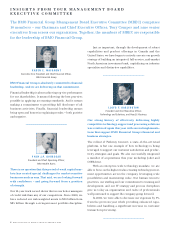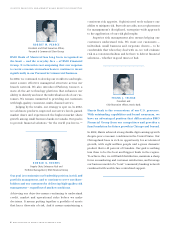Bank of Montreal 2002 Annual Report Download - page 15
Download and view the complete annual report
Please find page 15 of the 2002 Bank of Montreal annual report below. You can navigate through the pages in the report by either clicking on the pages listed below, or by using the keyword search tool below to find specific information within the annual report.
BMO FINANCIAL GROUP ANNUAL REPORT
2002
11
The following diagram illustrates the relationship between objectives, measures and targets at BMO Financial Group.
All targets exclude the effects of non-recurring items.2
2003 targets are based on the economic outlook discussed below.
OBJECTIVES, MEASURES AND TARGETS
Governing Objective
To maximize the total return to BMO shareholders and generate, over time, first-quartile total shareholder returns
relative to our Canadian and North American peer groups.
Financial Performance and Condition Objectives
Our performance objectives are to grow EPS1by a minimum of 10% per year over time and to increase cash ROE2
to between 19% and 20% over time. Our condition objective is to maintain a strong regulatory capital position
consistent with our peers.
2002 Financial Performance Targets 2002 Financial Performance
▪To achieve 8% to 12% cash EPS2growth
▪To increase cash ROE to between 14% and 15%
▪Provision for credit losses in the range of 40 to 50 basis points
Financial Performance Measures, Objectives and Targets
The most significant of our financial performance measures are
referred to as “primary measures”, while the less significant, which
tend to influence the primary measures, are referred to as “secondary
measures”. The most fundamental primary measure is the five-year
total shareholder return. When compared to peer group perfor-
mance, it assesses our success in achieving our governing objective.
We establish annual targets for certain of the performance and
condition measures. We also establish financial performance ob
-
jectives, which represent longer-term average annual minimum
levels of achievement. Our success in achieving our governing
objective of first-quartile total shareholder returns will depend
on our degree of success in surpassing our minimum financial
performance objectives and the performance of our peer group.
Because financial targets represent annual checkpoints in the
achievement of financial objectives, they reflect variable eco-
nomic conditions and may be higher or lower than the financial
objectives in any particular year.
Our operating philosophy is to increase revenues at a rate higher
than general economic growth rates and limit expense growth to
equal to or less than revenue growth, over time. We strive for
efficiencies in expense management and a balance between cur-
rent profitability and the need to invest for future growth. When
possible, expense efficiencies partially or totally fund the costs of
investing for the future. However, the relationship between reve-
nues and expenses in any year is affected by economic conditions.
1 All EPS figures in this MD&A refer to diluted EPS, unless indicated otherwise.
2 Adjustments to GAAP results to derive cash results and results excluding non-recurring items are outlined on page 18, along with comments on the use of these measures.
2002 Financial Condition Targets 2002 Financial Condition
▪To maintain a Tier 1 Capital Ratio of at least 8.0% ▪Tier 1 Capital Ratio of 8.80%
2003 Financial Performance Targets 2003 Financial Condition Target
▪To achieve 10% to 15% EPS growth (10% to 15% cash EPS growth)
▪To increase ROE to between 14% and 15% (cash ROE to between 15%
and 16%)
▪
To maintain a provision for credit losses at or below the 2002 level
($820 million)
▪To maintain a Tier 1 Capital Ratio of at least 8.0%
Much of the analysis of performance in the MD&A is framed
in the context of the primary and secondary measures discussed
above, which are used by management in assessing performance.
The measures are considered most relevant when they exclude
the effects of non-recurring items, as further discussed and de-
tailed on page 18. Financial performance targets outlined above
are stated on that basis. Cash earnings measures are also provided
at times because they can be informative, as explained on page 16.
Our targets for 2003 are established in the context of our
expectations for the economy in the year ahead, as detailed on
page 51. We anticipate that the economic factors that influence
our businesses will be similar in Canada and the United States.
GDP growth of 3.8% is expected in Canada, with growth of
approximately 3.2% in the United States. The jobless rate is
expected to trend lower and interest rates are expected to rise
steadily later in the year. Consumer and business credit are ex-
pectedtopickup.MortgagegrowthshouldremainhighinCanada
but may moderate somewhat from record highs in the United
States. We remain cautious about the near-term prospects for
capital and credit markets.
Prior Year Targets
In 2001, BMO achieved three of its nine financial targets, as
expense growth outstripped revenue growth and provisions for
credit losses increased significantly. In 2000, we achieved all
three of our financial targets.
▪Cash EPS growth of 8.6%
▪Cash ROE of 14.6%
▪
Provision for credit losses of $820 million or 56 basis points, consistent with
our updated estimate of April 2002
























